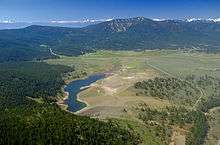Martis people
 Martis Creek Lake and Dam at the southern end of Nevada County near Truckee, California. | |
| Regions with significant populations | |
|---|---|
|
United States (California and Nevada) | |
| Related ethnic groups | |
| Maidu, possibly Washoe[1] |
The Martis were a group of Native Americans who lived in Northern California on both the eastern and western sides of the Sierra Nevada. The Martis complex lasted from 2000 BCE to 500 CE, during the Middle Archaic era.[2] Evidence of Martis habitation has been found from Carson River and Reno, Nevada in the east to Auburn, California and Oroville, California in the west.[3] The Martis name refers to the geographic region of Martis Creek which spans Nevada County, California and Placer County, California.[4][5]
Culture
Martis traveled to lower elevations in the winter and higher elevations in the summer in loose-knit groups. They lived in base camps on valley margins, often near hot springs. In the winter, they lived in pit houses with hearths, pit caches, and occasionally burials. Extended families are believed to have lived together. Summer camps were often located near springs or creeks.[6]
They shared certain traits which included making stone tools from basalt, using pestles and mortars, and hunting with atlatls and spears.[7] Martis engaged in a hunter-gatherer economic system.[8] Martis people processed seeds and hunted big game, such as mountain sheep, antelope, deer, bison, and elk.[9]
Descendants
Moratto states that the Martis were not related to the Washo, but may have been linked with the Maidu.[10] However, other scholars (Robert G. Elston and Catherine S. Fowler) suggest that the Martis complex overlaps culturally and geographically with the Kings Beach complex of ancestral Washoe people.[1]
Sites
The Meadow Lake Petroglyphs, attributed to the Martis, are a national historical landmark.[11] Another notable Martis archaeological site includes the Grouse Lakes Area of Nevada County, called the Martis Archaeological Complex, and cataloged as style 7 rock art.[12]
Others sites include Truckee Meadows–Steamboat Hot Springs, Bordertown, and Hallelujah Junction.[6]
Notes
- 1 2 D'Azevedo, 466
- ↑ Elston, 141, 143
- ↑ Brauman, Sharon K. (2004-10-06). "North fork petroglyphs". ucnrs.org. Retrieved 2008-08-15.
- ↑ Durham, David L. (2000). California's Gold Country: Includes Mariposa, Tuolumne, Calaveras, Amador, El Dorado, Placer, Sierra & Nevada Counties. Clovis, California: Quill Driver Books. p. 203. ISBN 1-884995-25-X. Retrieved 2008-08-15.
- ↑ Robbins, John (2000-12-14). "Action: Native American human remains and associated funerary objects:". thefederalregister.com. Archived from the original on 2008-09-19. Retrieved 2008-08-15.
- 1 2 Elston, 143
- ↑ Drake, Bill (2000). "Ancient petroglyph makers of the Northern Sierra". sierrarockart.org. Archived from the original on 2008-05-16. Retrieved 2008-08-15.
- ↑ "Prehistoric Context" (PDF). Idaho-Maryland Mine Project, Master Environmental Assessment. cityofgrassvalley.com. June 2006. p. 2. Retrieved 2008-08-15.
- ↑ Elston, 142, 145
- ↑ Moratto, M.J. (1984). California Archaeology (PDF). San Francisco: Academic Press. ISBN 0-12-506182-X. Retrieved 2008-08-15.
- ↑ "Meadow Lake Petroglyphs ** (added 1971 - Site - #71000169)". nationalregisterofhistoricplaces.com. Retrieved 2008-08-15.
- ↑ "Report on Potential Grouse Lakes Wilderness". forestissuesgroup.org. Retrieved 2008-08-15.
References
- D'Azevedo, Warren L. "Washoe." Handbook of North American Indians: Great Basin, Volume 11. Washington, DC: Smithsonian Institution, 1986. ISBN 978-0-16-004581-3.
- Elston, Robert G. "Prehistory of the Western Area." Handbook of North American Indians: Great Basin, Volume 11. Washington, DC: Smithsonian Institution, 1986. ISBN 978-0-16-004581-3.
Further reading
- Foster, D. G., Betts, J., & Sandelin, L. C. (1998). The association of Style 7 rock art and the Martis Complex in the northern Sierra Nevada of California. Sacramento: California Dept. of Forestry and Fire Protection. OCLC 42732872
- Gortner, W. A., & Elsasser, A. B. (1986). The Martis Indians: ancient tribe of the Sierra Nevada. Woodside, Calif: Portola Press. ISBN 0-936559-01-2
- Mires, P. B., Kautz, R., Botti, N., & Scott, E. (1992). Archaeological testing of nine locations along the Tahoe reach, Martis to Squaw Valley 120 kv transmission line project, Placer County, California. Nevada City, Calif: Forest Archaeologist, Tahoe National Forest. OCLC 44879837